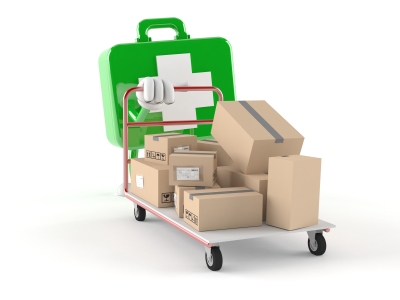Self Storage: First Aid Kits

First Aid Kits are relatively simple collections of medical equipment, designed to deliver what it says on the label: First Aid. This is not sophisticated medicine – just the basics to patch up minor injuries, such as cuts and sprains, or to provide a temporary measure until the victim of an injury can get proper treatment at a hospital, or until more expert medical help arrives.
A First Aid Kit for your self storage unit
Most First Aid Kits contain little more than sticking plasters, bandages and cleansing wipes. And that is probably all you need in a self storage unit.
Of course, if you always go to your self storage unit in your car, it would make more sense to carry a First Aid Kit in the car – unless you buy two (one for the car, one for your self storage unit). Note that in many countries (such as France), you are legally obliged to carry a First Aid Kit in your car, so perhaps you should get one anyway.
What should a First Aid Kit contain?
You can buy readymade First Aid Kits in pharmacies, larger supermarkets, garage shops, or online. This is usually the cheapest way to buy one (they cost around £12): if you try to assemble all the separate components yourself, it will probably cost more. And with a readymade First Aid Kit you will get a neat, purpose-built and labelled bag.
All readymade First Aid Kits are slightly different: there is no set formula for what they contain. But most will have the following:
1. Standard sticking plasters (‘adhesive dressings’). In various sizes, usually in a box of about 20; used to cover minor cuts and wounds to stop bleeding and keep the wound clean. They can also be used to protect skin from rubbing (e.g. in a shoe).
2. Triangular bandages. Large cloth bandages, big enough to form a sling to support an injured hand or arm (with a knot at the back of the neck).
3. Sterile wound dressings. Made of a light textile (such as Melolin), they are placed over a wound and secured with a bandage. They usually come in three sizes: medium, large and extra large.
4. Absorbent gauze roll. Used to bind around and cover wounds.
5. Crepe bandages. These are strong textile bandages, typically 4.5m long and 5cm or 7.5cm wide, packaged in rolls. They are used to bind and support injured limbs, and to secure dressings on wounds.
6. Adhesive tape. Elastoplast or micropore tape, used to bind bandages in place.
7. Alcohol-free antiseptic cleansing wipes. These usually come individually wrapped, and are used to clean cuts and grazes in order to minimise the risk of infection. They can also be used to clean your hands when soap and water are not available.
8. Safety pins. Used to secure bandages. The sharp tip can also be used to puncture blisters, and to remove splinters and thorns (but clean the tip first with a cleansing wipe).
9. Scissors. Used to cut bandages and other dressings to size. First Aid scissors tend to be small, and often have rounded tips to prevent accidental wounding.
10. Tweezers. Flat-tipped tweezers, used to remove splinters, embedded grit, bee-stings etc.
OTHER ITEMS TO CONSIDER
11. Antiseptic cream. Applied to minor cuts and abrasions, to reduce the risk of infection. (Savlon is perhaps the best-known brand.)
12. Painkilling tablets. E.g. aspirin, paracetamol, or ibuprofen, for headaches and general pain relief.
A First Aid manual may also come in handy. It will tell you how to use the First Aid Kit, and what to do in an emergency.
First Aid Kits for the Self Storage Office
A First Aid Kit (or First Aid Box) is an essential piece of kit in the workplace. Quite what it should contain will depend on the size and scope of the self storage facility, and the risks implied.
The Health and Safety Executive (HSE) publishes a useful document (available online as a pdf) called ‘First Aid at Work: Your Questions Answered’.
As it says, ‘The Health and Safety (First-Aid) Regulations 1981 require you to provide adequate and appropriate first-aid equipment, facilities and people so your employees can be given immediate help if they are injured or taken ill at work. What is “adequate and appropriate” will depend on the circumstances in your workplace and you should assess what your first-aid needs are.’
For more details about First Aid issues in the workplace, and statutory requirements, see the website of the Health and Safety Executive.
For further information about First Aid, see the Accidents and First Aid section of the NHS website.
Leave a Reply
Subscribe to This Blog
Get new blog posts sent to you by subscribing to RSS updates or to email updates.






